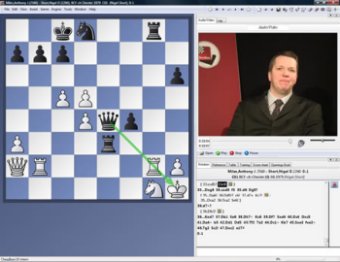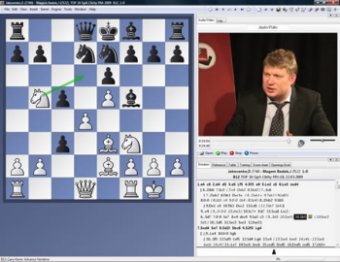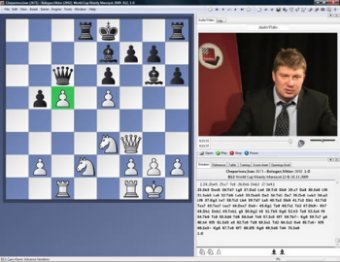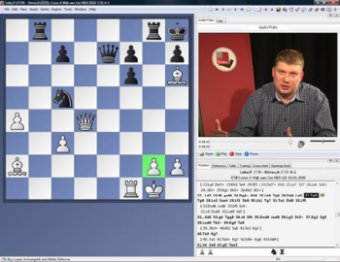 |
ChessBase Reviews |
Last updated 2 August 2010

| index |
CDs, DVDs, Software Part 42

Rybka 4 By ChessBase
For years Rybka has been the uncontested number one in computer chess and since its great breakthrough in 2006 the program has won with remarkable regularity one world title after the other. So that this state of affairs will continue in the future, the Rybka-team gathered around programmer Vasik Rajlich has developed a new version which is even better: "Rybka 4 plays more aggressively and more tactically". Available from 28 May.
During the last two years the engine has been improved in almost all areas. One major theme has been the understanding of the attack on the king. The new Rybka 4 is in this case more precise and reliable than its predecessor. At the same time the search function now operates more quickly and efficiently and the evaluation function delivers even more spot-on judgments.
As for the playing style, Rybka 4 logically continues the development of the past few years. Thanks to further development in the tactical area too, the new Rybka 4 will be indispensable for all those who work and analyse with chess engines. Rybka 4 is delivered with the new user-friendly Fritz 12 interface and contains a database of 1.5 million games and includes CLASSIC membership for playchess.com for one year.
System requirements: Minimum: Minimum: Pentium III 1 GHz, 512 MB RAM, Windows Vista, XP (Service Pack 3), DirectX9 graphics card with 256 MB RAM, DVD-ROM drive, Windows-Media Player 9, internet access (playchess. com, updates and activation). Recommended: PC Intel Core 2 Quad, 2.4 GHz, 3 GB RAM, Windows Vista or Windows 7, DirectX10 graphics card (or compatible) with 512 MB RAM or more, 100% DirectX10 compatible, sound card, Windows Media Player 11, DVD ROM drive and internet access (playchess.com, updates and activation). The activation of the program requires internet access.
This playing program also comes with a separate book to use alongside the program. The playing book is specifically designed to improve Rybka’s playing performance and I would highly recommend it to the serious chess player.

Greatest Hits Vol 2 By Nigel Short
Nigel David Short is generally regarded as the strongest British grandmaster of the 20th century. Born on June 1st 1965 he started out as a chess prodigy, first attracting media attention by beating Viktor Korchnoi and Tigran Petrosian in simultaneous exhibitions at the age of ten and twelve years respectively. At the age of 14 he became the youngest IM in history, breaking Bobby Fischer’s previous record, and at 16 he came second (to Garry Kasparov) at the under 20 World Junior Championship in Dortmund.

In 1985 Nigel became Britian’s first ever candidate for the World Championship, and in 1993 he made it all the way to the final by beating Anatoly Karpov and Jan Timman. He only lost to World Champion Garry Kasparov in the title match in London. Since then he has remained active at the highest levels of competitive chess, but has also become a chess columnist, commentator and also a coach for promising young talents. He is considered one of the most entertaining and outspoken personalities in the chess world.
In In his DVDs “Greatest Hits” Nigel takes us on an electrifying journey through a very rich chess career, which saw him beat no less
than twelve world champions. His experience in tournaments and matches all over the world – Short has visited a total of 89 countries –
can be seen in the narratives that precede the games which he annotates with humour and instructive insights. Video running time: more
than 5 hours. Contents include:
Short - Miles: Chester, 1979;
Short - Ye: Shianjin, 2004;
Short - Gelfand: Brussels, 1991;
Gurevich - Short: Manila, 1991;
Short - Seirawan: Luzern, 1989;
Short - Khalifman: Bundesliga 1991;
Short - Ljubojevic: Belgrade, 1989;
Kasparov - Short: London, 1987;
Short - Pogorelov: Gibraltar, 2004;
Epishin - Short: Malmö, 2002;
Short - Timman: Reykjavik, 1987;
Short - Adams: England, 1991;
Illescas - Short: Pamplona, 1999;
Korchnoi - Short: Luzern, 1989;
Gligoric - Short: London, 1980.

Advance Caro-Kann 2nd Edition By Alexej Shirov
The Caro-Kann Defence, which arises after the moves 1.e4 c6 followed by d7-d5, is considered to be one of the most reliable defences to White’s 1.e4. Black fights for his share of the centre and patiently awaits his chance. Shirov’s preferred weapon against this solid setup by Black has always been the Advance Variation 3.e5 - with chances and risks for both sides. The main focus of the DVD is on plans for both White and Black after 1.e4 c6 2.d4 d5 3.e5 Bf5; the Latvian super-grandmaster explains these with the help of the best games culled from his own praxis, as well as three theoretically important games played by others.

The material which has been added for this new edition concentrates on the variations after 4.Nf3 e6 5.Be2. Video running time: 7.5 hours.

Alexej Shirov was born in Riga just like world champion Mihail Tal, and also his playing style reminds many chess fans of the young Tal. In the beginning of the 90ies, a comet-like rise brought the young Latvian to the world top within the shortest of time. Being no older than 22 years, he already had an Elo rating of nearly 2750 and belonged to the absolute elite. Since then Shirov has been one of the best players in the world, delighting all chess fans with original and amazing ideas on the board.

Guide to the Tkachiev Ruy Lopez By Alexej Shirov
The variation against the Ruy Lopez presented in meticulous detail by Alexei Shirov (3...a6 4.Ba4 Nf6 5.0-0 b5 6.Bb3 Bc5) has so far had no recognised name and Shirov himself has named it after Vladislav Tkachiev, the 2007 European champion, the Tkachiev Ruy Lopez. In fact the grandmaster from Kazakhstan has played a few important games with this system, but it would have been just as justified to name the variation after our author himself, because since 1996 Shirov has not only played numerous games with it, but recently he has turned it into his main weapon against 1.e4 - with splendid success and a lot of imitators.

The super grandmaster now shares all this collected knowledge with his viewers. Apart from the Exchange Variation (to which Shirov also devotes a model game) White has hardly any serious deviation after 3.Bb5, making of the Tkachiev Variation a good weapon against the Ruy Lopez. Video running time: 6 hours.

Alexei Shirov was born in Riga just like world champion Mihail Tal, and also his playing style reminds many chess fans of the young Tal. In the beginning of the 90ies, a comet-like rise brought the young Latvian to the world top within the shortest of time.
Being no older than 22 years, he already had an Elo rating of nearly 2750 and belonged to the absolute elite. Since then Shirov has been one of the best players in the world, delighting all chess fans with original and amazing ideas on the board.

The Smith Morra Gambit By Lawrence Trent
What do you do against the Sicilian Defence? Do you play a mainline, safe in the knowledge that despite being the most reliable way to gain an opening advantage, you could be condemned to spending years studying a huge body of opening theory, or do you choose an Anti-Sicilian, a way to sidestep the mainlines at the risk of allowing Black to have a sneaking chance to achieve equality?

The Morra Gambit, characterised by the moves 1.e4 c5 2.d4 cxd4 3.c3 is one of the least played, yet according to IM Trent most underrated Anti-Sicilians that White has at his disposal. By sacrificing a pawn, White aims to rapidly develop his pieces with the objective of delivering a swift knockout blow to the unprepared Black camp.
Objectively speaking, Trent emphasises, if Black knows his stuff he has various ways to achieve a perfectly reasonable position. The beauty of this opening, Trent explains, lies in its practical "over-theboard" potential.

Black players will have trouble coping with unknown positions and being put on the back foot from the start. It should be of no surprise that around 50% of players with Black decide to decline the gambit, but even in this case Trent presents a host of tricky variations which allow White to play with venom and great attacking possibilities, not to mention a number of previously unseen theoretical novelties! Video running time: 5 h 25 min.
Lawrence Trent is an International Master from England. He has represented England as a player and as a coach and has been a 3-time winner of the Porto San Giorgio International tournament, finishing ahead of many Grandmasters.